  Jim Young was the oldest retiree in attendance at the K-25 site reunion. The 101-year-old started working at the K-25 site as a security guard in May 1944.
OAK RIDGE, Tenn. – Long vacant parking lots at the former K-25 site at Oak Ridge were full again on a recent Saturday afternoon as retired employees gathered for a first-ever reunion.
“There are some folks here that I have not seen since I retired,” said Bob Merriman, who began working at the K-25 site in 1963. “It’s amazing to be able to visit with them and to see them still doing well.”
What started as a plan to host a small picnic quickly turned into much more.
“I said we’ll have it down here at Turtle Park in Oak Ridge, but I think I’m going to open it up to all K-25 workers,” said Pam Toon, an event organizer who started work at the site in 1987. “When I did, massive amounts of people signed up.”
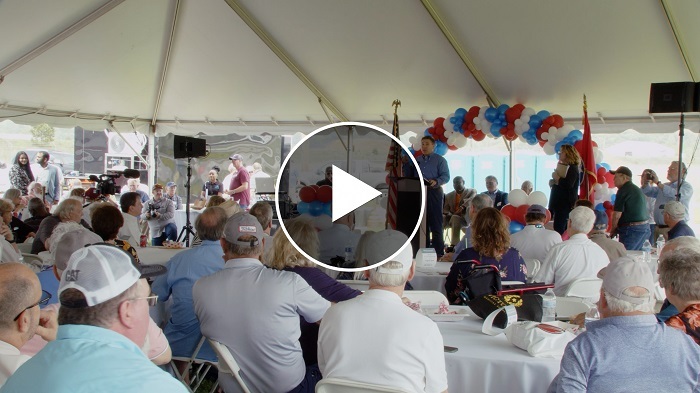 EMTV: Watch this video to see more coverage of the K-25 site reunion.
More than 650 former K-25 employees jumped at the chance to see friends from years past. All of them arrived thankful for an opportunity to reconnect and share memories that go back generations.
“It feels wonderful to see faces you haven’t seen in years,” said Harold Conner, who began working at the site in 1964.
The oldest attendee was 101-year-old Jim Young, who began working there in 1944 as a security guard.
He recalled how busy the site was while it was being built and operated during the Manhattan Project.
“It was as crowded as a city, and you couldn’t walk without bumping into someone,” said Young.
The K-25 plant played an essential role in the top-secret Manhattan Project to help end World War II. Inside what was once the world’s largest building, employees enriched uranium used in the first atomic weapon.
“When they dropped that bomb, when we got back to work, the security part didn’t change a bit. Some of the security guys thought we’d be going home,” Young said.
But they didn’t.
Over the next 40 years, employees at the K-25 site enriched uranium that powered the nuclear Navy, produced fuel for 14 countries and developed new enrichment technologies. In one of its lesser known roles, the facility also housed Oak Ridge’s first supercomputer.
“Fusion was the main focus, but it wasn’t the only thing,” said Merriman. “There was a lot of isotope separation theory that was developed here. Also, there was an intelligence organization headquartered here that provided a lot of support to the intelligence community as it related to what other countries were doing or might be doing in uranium enrichment and fuel reprocessing and things like that.”
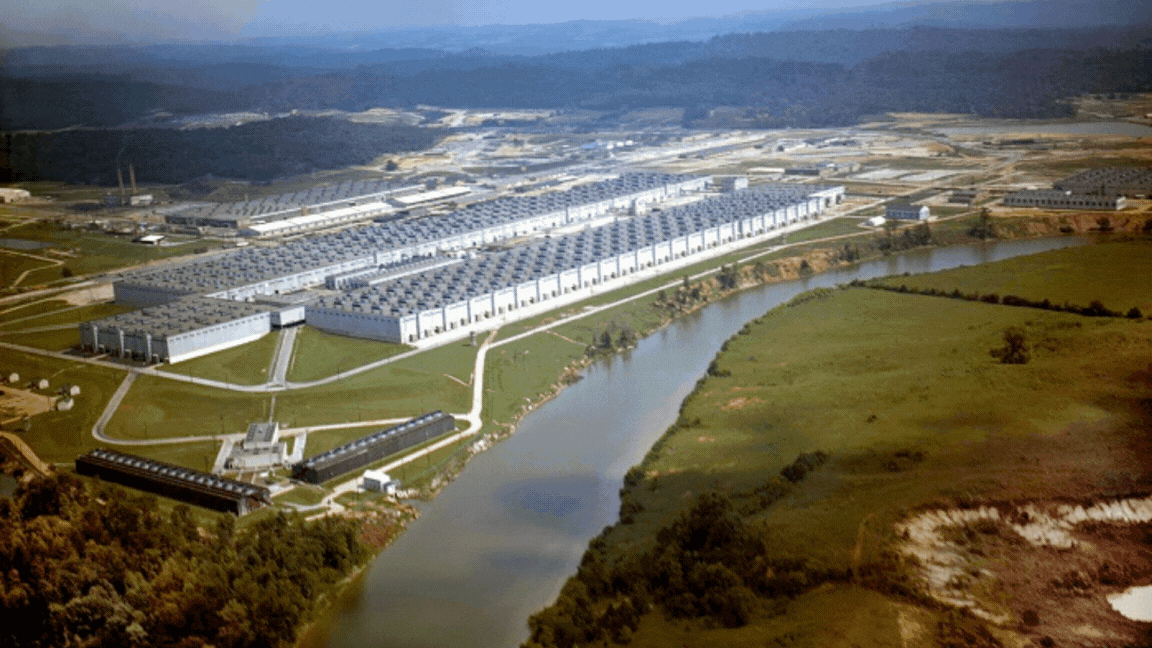 When it was constructed during the Manhattan Project, the K-25 building was the largest in the world. The first photo here shows the former K-25 site and Poplar Creek in 1950. The second photo shows a view of the site in 1983 before it was closed permanently in 1987. Over the years, employees there enriched uranium that powered the nuclear Navy, produced fuel for 14 countries and developed new enrichment technologies.
Although the site was closed permanently in 1987, the impact of these men and women remains.
“More people need to be appreciative of the people that worked here, and what they did. And people need to be recognized for that,” Toon said.
The U.S. Department of Energy Office of Environmental Management (EM) built the K-25 History Center, and it will open the new K-25 Viewing Platform next year. Both the center and platform share the story of what happened at the site.
Through EM’s work, all buildings at the former K-25 site have been cleared away. Those projects eliminated hazards and cleared land the community can reuse for economic development.
While reunion attendees expressed sadness to see their places of work no longer standing, they also shared excitement that the site can have a new chapter that benefits the nation.
Due to the popularity of the reunion, organizers are making plans to host another reunion set for April 26, 2025. Next year marks the 80th anniversary of the K-25 site.
-Contributor: Ben Williams
 
SANTA FE, N.M. — The U.S. Department of Energy Office of Environmental Management's (EM) longest established working group — the State and Tribal Government Working Group (STGWG) — drew the largest number of participants ever for its spring meeting, with nearly double the usual attendance. With a focus on the nearby Los Alamos National Laboratory (LANL) and EM’s legacy cleanup work there, the meeting also featured a half-day dialogue on tribal sacred sites and cultural resource management plans, including EM’s recent review of plans across the EM complex. The Santa Clara Pueblo at Puye Cliffs, home to 1,500 Pueblo Indians who had farmed, hunted and lived there for centuries, hosted the meeting participants. Raymond Martinez, lieutenant governor of the Pueblo de San Ildefonso, shared some of that history during a LANL tour the group attended. “Our people still hunt and use this area as they have for hundreds of years,” Martinez said. EM Principal Deputy Assistant Secretary Jeff Avery attended the events and said, “Spending time with Governors Moquino and Chavarria (of Pueblo de San Ildefonso and Santa Clara Pueblo, respectively) opened my eyes to some of the challenges their communities face.” EM Tribal Affairs Advisor Jill Conrad added, “Great dialogue is an indication of a great meeting. There’s no replacement for in-person conversations.” In addition to attending STGWG meetings, Avery also traveled to the Pueblo de Cochiti, Pueblo of Jemez and Santa Clara Pueblo to deepen his understanding of cultural values and priorities as well as the impacts of the presence of United States federal entities near these communities.
-Contributor: Jill Conrad
  Robotics and Artificial Intelligence Workshop for Nuclear Decommissioning attendees at Florida International University gather for a photo.
MIAMI — U.S. Department of Energy (DOE) Office of Environmental Management (EM) representatives recently explored technical challenges and solutions and celebrated the opening of a new facility for robotics and artificial intelligence research conducted for EM and other organizations during an inaugural workshop hosted by the Applied Research Center (ARC) at Florida International University (FIU).
Held at FIU’s Modesto Maidique Campus and Engineering Center, the Robotics and Artificial Intelligence Workshop for Nuclear Decommissioning kicked off with welcoming remarks from Inés Triay, interim dean of FIU’s College of Engineering and Computing, Leonel Lagos, ARC’s director of research, and Rodrigo Rimando, director of EM’s Technology Operations Office.
Workshop attendees included personnel from EM cleanup sites, DOE national laboratories, DOE contractors, International Atomic Energy Agency (IAEA) and other international research centers, U.S. Army Corp of Engineers, U.S. Department of Defense, Georgia Tech, Institute for Human and Machine Cognition, Florida state and community colleges, and private industry. FIU staff, faculty and students also took part.
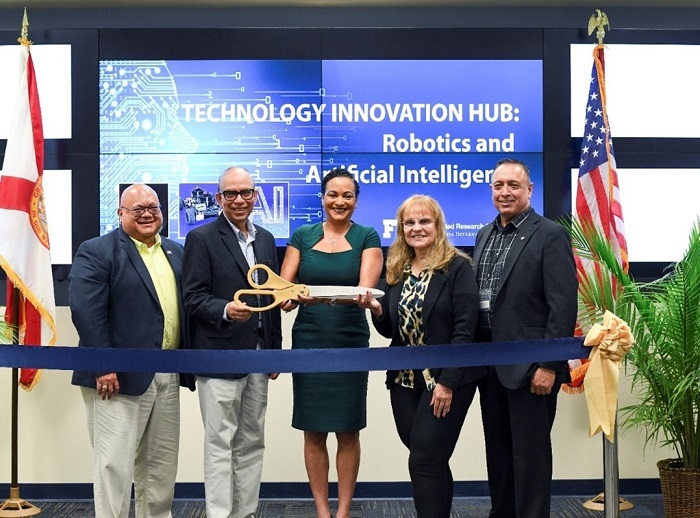 Officials take part in a ribbon cutting ceremony for the Florida International University (FIU) Technology Innovation Hub: Applied Robotics and Artificial Intelligence. From left are Rod Rimando, director of the Technology Operations Office at the U.S. Department of Energy Office of Environmental Management; Himanshu Upadhyay, associate professor for the FIU College of Electrical & Computer Engineering; Heather Russell, vice provost, Faculty Leadership & Success, FIU Office of the Provost; Inés Triay, interim dean, FIU College of Engineering and Computing; and Leonel Lagos, director of research, FIU Applied Research Center, and associate professor, Moss Construction Management.
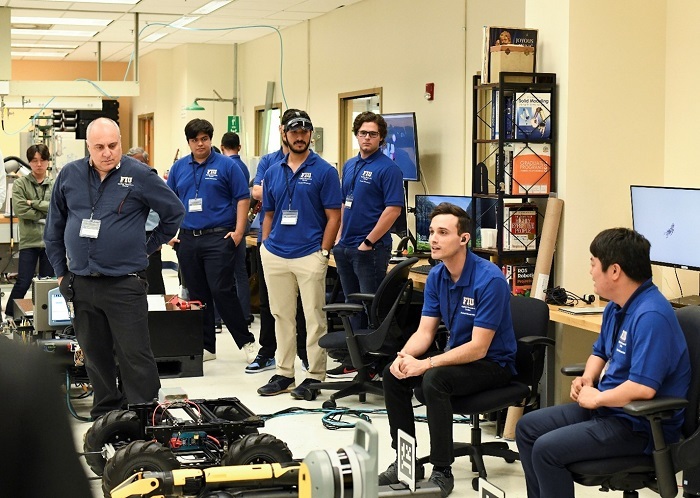 Florida International University fellows and U.S. Department of Energy Office of Environmental Management Minority Serving Institutions Partnership Program fellows present research during a lab tour at the newly inaugurated Technology Innovation Hub: Applied Robotics and Artificial Intelligence.
 Florida International University Applied Research Center (ARC) Research Scientist Anthony Abrahao presents during lab tours at ARC.
The first day of the workshop was dedicated to technical challenges at federal agencies such as DOE and across the globe from the perspective of IAEA.
The second day addressed technical solutions being developed and implemented at DOE sites, national laboratories and contractors, and other federal agencies.
The third day’s focus was on the presentation of several international projects conducted at IAEA, as well as other agencies in Germany, Norway and South Korea. Participants also discussed workforce development needs and opportunities.
Workshop participants also inaugurated FIU’s Technology Innovation Hub: Applied Robotics and Artificial Intelligence. Heather Russell from FIU’s Office of the Provost delivered brief remarks and assisted in the ribbon cutting ceremony. The new facility will serve as a focal point for robotics and artificial intelligence research being conducted for EM, other federal agencies, private industry and international partners. It will also serve as a training and education center for science, technology, engineering and math (STEM) students interested in research and development in those areas.
The ribbon cutting ceremony was followed by lab tours of the newly inaugurated research facility, as well as other labs at ARC supporting EM and DOE Office of Legacy Management applied research as part of a cooperative agreement between DOE and FIU.
 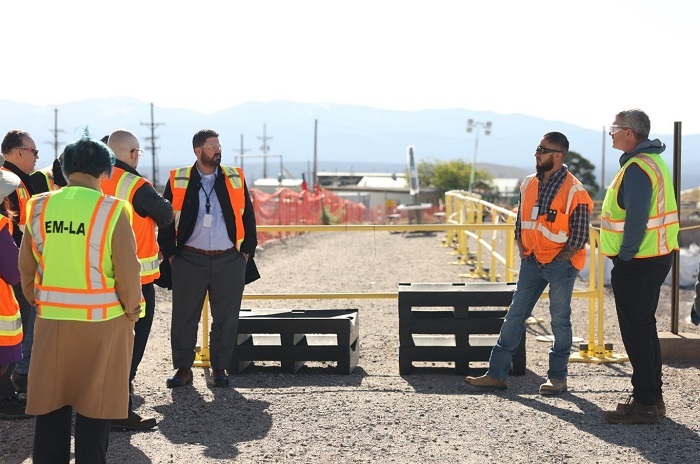 U.S. Department of Energy Office of Environmental Management (EM) Principal Deputy Assistant Secretary Jeff Avery, left, visits Technical Area 54, Area G to learn more about the work to retrieve buried corrugated metal pipes (CMPs) and prepare them for eventual disposal at EM’s Waste Isolation Pilot Plant. As of May 15, 87 of the 158 total CMPs have been retrieved.
LOS ALAMOS, N.M. — U.S. Department of Energy Office of Environmental Management (EM) Principal Deputy Assistant Secretary Jeff Avery recently viewed the legacy cleanup mission underway at Los Alamos National Laboratory (LANL). During his visit, Avery observed the progress the EM Los Alamos Field Office and Newport News Nuclear BWXT Los Alamos, the legacy cleanup contractor at LANL, are making to address a set of corrugated metal pipes containing cemented transuranic waste. Avery also viewed a new waste characterization system undergoing testing at LANL that could help EM to more accurately measure and characterize legacy waste, and optimize space for the disposition of transuranic waste at EM’s Waste Isolation Pilot Plant.
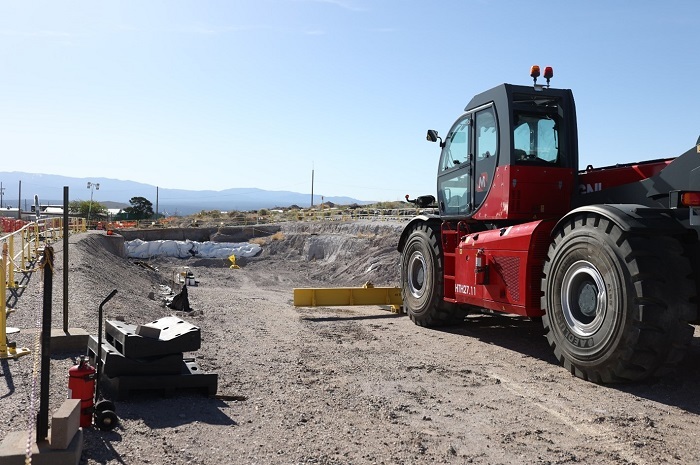 Work progresses at Technical Area 54, Area G to retrieve the buried corrugated metal pipes (CMPs) to prepare them for eventual shipment to the Waste Isolation Pilot Plant. Each CMP measures about 20 feet long, weighs between 5 and 7 tons and contains cemented, radioactive material. Once retrieved, CMPs are transported to Dome 375, where they are cut into pieces using a hydraulic shear and loaded into standard waste boxes.
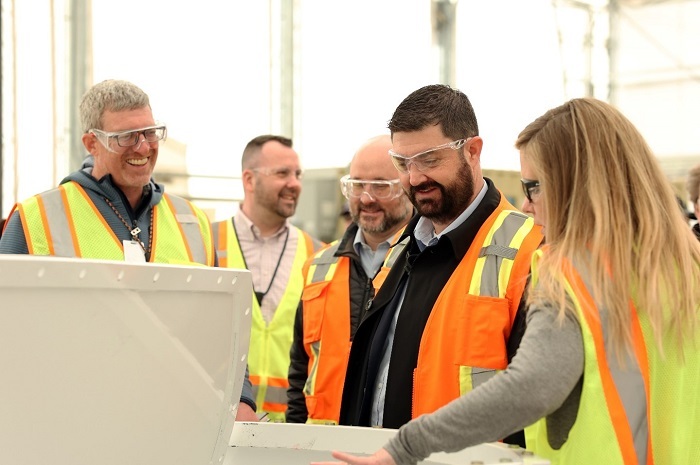 Guided by members of the Environmental Management Los Alamos Field Office and Newport News Nuclear BWXT Los Alamos team, U.S. Department of Energy Office of Environmental Management (EM) Principal Deputy Assistant Secretary Jeff Avery, fourth from left, observes the process used to reduce the size of retrieved corrugated metal pipes to prepare them for packaging and eventual offsite disposal at EM’s Waste Isolation Pilot Plant.
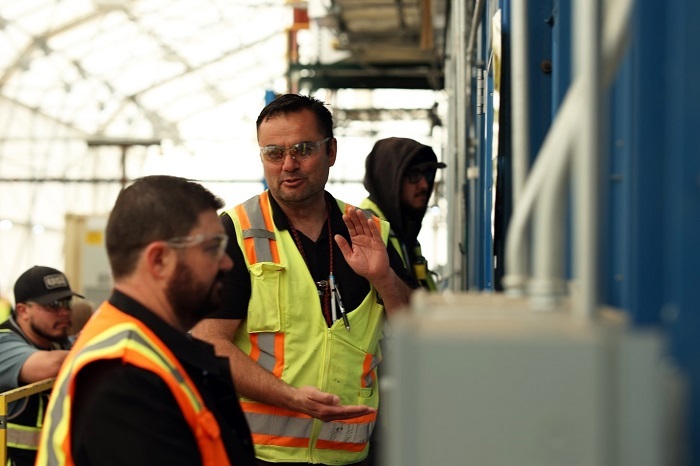 Charles Guillen, director of Waste Management, Newport News Nuclear BWXT Los Alamos, shows U.S. Department of Energy Office of Environmental Management Principal Deputy Assistant Secretary Jeff Avery, left, where corrugated metal pipes are safely cut into pieces using a hydraulic shear inside Dome 375 at Technical Area 54, Area G.
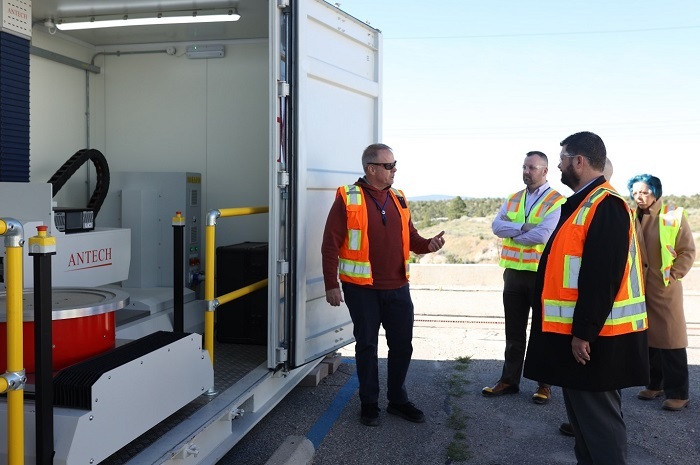 The Universal Drum Assay and Segregation System (UDASS), a new system to more accurately analyze the contents of radioactive waste drums, is currently being tested on legacy waste at Los Alamos National Laboratory. Standing next to the UDASS system are U.S. Department of Energy Office of Environmental Management (EM) Principal Deputy Assistant Secretary Jeff Avery, right foreground, and members of the EM and Newport News Nuclear BWXT Los Alamos teams. Read a story about UDASS in this EM Update issue.
  A collaboration between the U.S. Department of Energy Office of Environmental Management’s Office of River Protection and Bechtel National Inc. set a foundation for requirements engineers will follow in continuing the design of the Hanford Site’s High-Level Waste Facility. Lourdes Legaspi, Engineering Automation supervisor, center, and her team are designing pipe and equipment components.
RICHLAND, Wash. —The U.S. Department of Energy Office of Environmental Management’s (EM) Office of River Protection and contractor Bechtel National Inc. recently created a plan for completing the High-Level Waste (HLW) Facility at the Hanford Site’s Waste Treatment and Immobilization Plant.
Together they laid out the strategy for completing the design and construction of the partially built facility that will immobilize in glass millions of gallons of radioactive and chemical waste from large, underground tanks at Hanford.
“We have a strong plan on what technical and programmatic requirements will drive the path to completing Hanford’s high-level waste treatment mission,” said Tom Teynor, Hanford HLW Facility project manager. “The collaboration is an example of how EM and its contractors can partner to produce positive outcomes.”
Felice Presti, Bechtel principal vice president and project manager for HLW, said, “Achieving alignment early reduces uncertainties, supports cost and schedule estimating and planning for future work, and it serves as a foundation for success going forward.”
The team incorporated lessons learned from the engineering, procurement, construction and commissioning of the plant’s Low-Activity Waste Facility and other facilities in EM’s Direct-Feed Low-Activity Waste Program.
A key aspect of the way ahead is completing design work before doing major construction work. The team also focused on determining criteria for accepting waste from Hanford's Tank Farms; using additional mock-ups, or simulated work environments with no radiological or chemical hazards; and involving experienced operators early in planning.
“These actions establish a strong foundation for making the High-Level Waste Facility Project a model for future projects,” said Teynor.
Like the Low-Activity Waste Facility, the HLW Facility will mix tank waste with glass-forming materials in two large melters operating at 2,100 degrees Fahrenheit. The mixture will be poured into stainless steel containers for interim safe storage prior to disposal.
-Contributor: Tyler Oates
 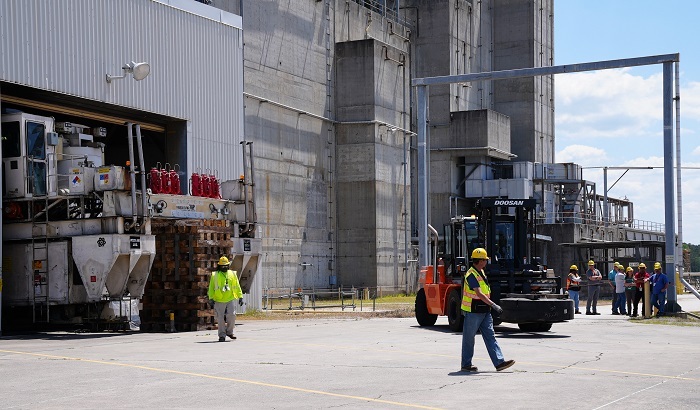 At right, a forklift moves a 2,500-pound tire to be installed on the Shielded Canister Transporter, at left, a unique vehicle used to transport stainless steel canisters of glassified high-level waste for storage at the Savannah River Site (SRS). Crews recently completed significant upgrades to keep it operational for the SRS liquid waste mission.
AIKEN, S.C. — The massive, unique vehicle used to transport highly radioactive canisters at the Savannah River Site (SRS) has completed an important pit stop to ensure continued, reliable movement of the site’s liquid waste mission.
The Shielded Canister Transporter (SCT) carries the stainless steel canisters filled with glassified, high-level radioactive waste, one at a time, from the Defense Waste Processing Facility (DWPF) to nearby Glass Waste Storage Buildings (GWSBs). Inside a GWSB, the transporter lowers each canister into a below-grade concrete vault containing support frames for vertical storage of the canisters. The buildings are for interim storage until a federal repository is ready to receive the canisters.
Measuring more than 18 feet tall and 25 feet long, and weighing 235,000 pounds, the SCT is a front-wheel-drive vehicle powered by diesel engines. It clocks in at a top speed of around 3 mph.
The U.S. Department of Energy Office of Environmental Management liquid waste contractor at SRS, Savannah River Mission Completion (SRMC), operates and maintains the SCT.
The recent pit stop included repairing brakes, servicing drive motors and installing eight new rubber tires — each weighing 2,500 pounds. The maintenance took approximately two weeks, but there was no impact to operations since production was paused for a site-wide steam outage so needed facility maintenance could take place.
In its 28 years, the SCT has traveled 1,980 miles between the DWPF and the two GWSBs — a trek equal to 792 laps around the Daytona International Speedway. It has transported more than 4,400 canisters to the GWSBs. DWPF is expected to produce over 8,100 canisters over the life of the project.
Operators also use the SCT to relocate canisters to enable vault modifications for double-stacking canisters in a single storage slot — a milestone recently completed in GWSB 1 by SRMC.
The SCT is critical to the SRS liquid waste cleanup process, according to Jim Folk, DOE-Savannah River assistant manager for waste disposition.
“The Shielded Canister Transporter is the only way the canisters of high-level waste can leave the Defense Waste Processing Facility to be safely stored onsite, and there is not another one like it,” Folk said. “Maintaining reliable operation of the transporter is critical to the highly integrated and interconnected SRS liquid waste system.”
SRMC Chief Operations Officer Wyatt Clark said that SRMC crews continue to take great care of this machine to ensure longevity over the mission.
“All the corrective and preventive maintenance is done by skilled SRMC mechanics,” Clark said. “Because of their diligent work, we are able to ensure reliability of this critical vehicle as we continue to pursue our mission to reduce the risk to people and the environment of the radioactive waste stored at SRS. There is only one Shielded Canister Transporter, and we have to keep it moving.”
-Contributor: Colleen Hart

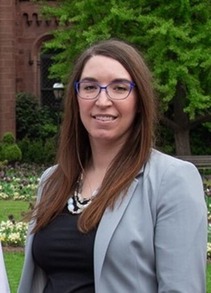
LOS ALAMOS, N.M. – The U.S. Department of Energy Office of Environmental Management (EM) has selected Jessica Kunkle as the next EM Los Alamos Field Office (EM-LA) manager, effective June 16.
EM-LA’s acting field office manager, Ellie Gilbertson, will return to her role as EM-LA deputy manager. Kunkle succeeds Michael Mikolanis, who was appointed to the position of National Nuclear Security Administration (NNSA) Savannah River Field Office manager in April.
Kunkle will join EM-LA from NNSA’s Office of Infrastructure Lifecycle Management in Washington, D.C., where she has served as deputy associate administrator, responsible for providing overall leadership and direction of activities for a $3 billion program portfolio modernizing, operating and sustaining real property across the NNSA Nuclear Security Enterprise. In this role, Kunkle provided leadership and direction for complex, cross-functional programs and initiatives spanning infrastructure planning, financial management, risk assessment, communications and non-traditional infrastructure acquisitions. She recently served as acting manager of NNSA’s Savannah River Field Office and has held other leadership positions with NNSA.
Originally from Los Alamos, Kunkle is a strategic leader with a commitment and track record of building strong collaborative relationships. Her vast experience makes her uniquely qualified to advance the cleanup mission at EM-LA.
|
 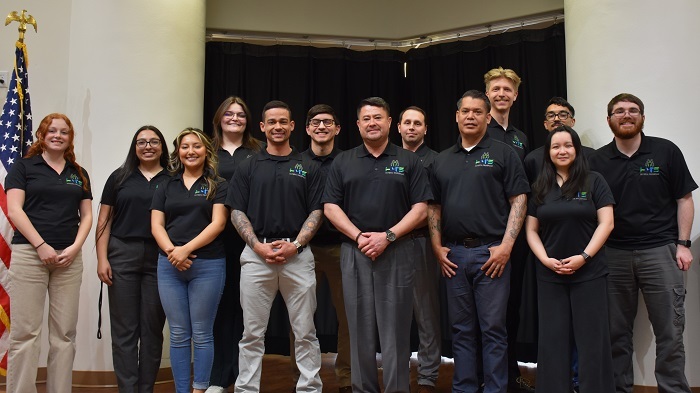 Hanford Site contractor Hanford Mission Integration Solutions’ 2024 co-op interns pose for a photo after their final presentations to company leadership. From left: Tory Stone, Cristal Meza, Jasmine Morales, Courtney Wilkinson, Franklin Leon, Jaime Mireles, Emilio Avila, Baily Ellingford, Abel Melendrez, Maksim Karazhbei, German Anguiano, Christina Paul and Andrew Jurgilewicz.
RICHLAND, Wash. — An internship program administered by U.S. Department of Energy Office of Environmental Management contractor Hanford Mission Integration Solutions (HMIS) is preparing a workforce with skills to meet future cleanup needs at the Hanford Site, an example of how the One Hanford team is developing and retaining new talent.
“Internships with the Hanford Site serve a dual purpose,” said Sydney Nachbaur, Hanford’s Workforce Resource manager. “They help us cultivate the future workforce while connecting local students and military veterans with on-the-job experience in their respective fields.”
Initiated in 2021, the HMIS Co-Op Internship Program matches college students and individuals seeking career transitions, including veterans, with work that complements their academic studies or professional goals. Students also have opportunities for scholarships funded by HMIS to support their education.
Since the program’s launch, it has welcomed 32 graduates into full-time positions at HMIS, highlighting its effectiveness in building a robust workforce equipped to support Hanford’s cleanup mission.
Abel Melendrez, a 22-year Army veteran and intern with the HMIS Safeguards and Security team, reflected on the program's effects: "This internship offered me a path to transition my career post-military, complete my degree and provide for my family, all while adapting to a new professional environment."
While the HMIS Co-Op Internship Program does not guarantee employment after the internship term ends, its primary goal is to transition as many interns as possible into full-time roles, preparing them with skills and experience required to be effective and successful members of the Hanford Site workforce in the future.
-Contributor: Shyanne Palmus
  CTI and Associates Inc. was tasked with the deactivation and demolition of the Savannah River Site legacy coal handling facility at the D Area powerhouse. This project included asbestos abatement and removal of a coal feed conveyer.
AIKEN, S.C. — A U.S. Department of Energy Office of Environmental Management (EM) contractor at the Savannah River Site (SRS) is helping small businesses through the DOE Mentor-Protégé Program (MPP), more than doubling a protégé firm’s revenue, improving its capabilities and broadening its customer base.
The Savannah River Nuclear Solutions (SRNS) MPP improves the subcontracting abilities of small businesses within the DOE complex. Since 2016, the program at SRS has grown from managing one protégé annually to managing five protégés each year, increasing the SRNS investment in small businesses over that period from $400,000 to $41 million.
“We offer technical and developmental support to protégés, equipping them with the necessary knowledge, skills and capabilities to successfully compete for DOE prime contracts,” said Lisa Tanner, SRNS Supply Chain Small Business liaison officer.
In 2018, SRNS selected CTI and Associates Inc. (CTI), a small construction and remediation company based in Michigan, to perform field work.
“CTI has grown significantly with SRS expanding our task orders to include more capable jobs and increased opportunity,” said Morgan Subbarayan, CTI president. “This mentorship has allowed us to grow our production payroll, improve infrastructure, enhance our safety program and completely transform our business and technical capabilities.”
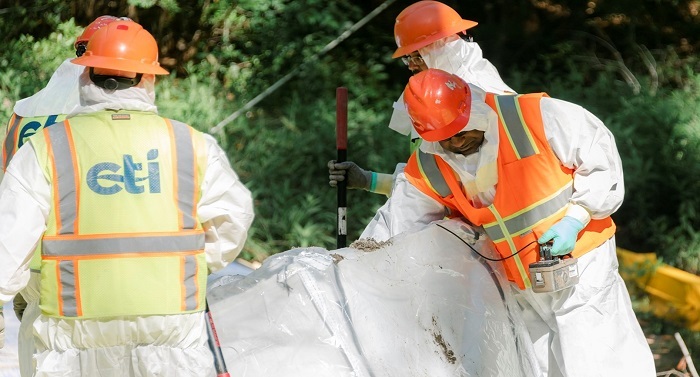 CTI and Associates Inc. personnel remove contaminated sediment from the R-Reactor Discharge Canal at Savannah River Site.
In 2020, CTI faced significant challenges due to the coronavirus pandemic. Its partnership with SRNS proved to be a turning point, as it expanded CTI’s capabilities and grew the company from 91 to over 200 employees.
“The confidence SRNS has instilled into our business has created a work culture that is thriving and constantly evolving,” Subbarayan added. “We have expanded from simple deconstruction to include heavy civil and rad exposure, capturing the attention of Oak Ridge National Laboratory and Hanford.”
To date, CTI has successfully delivered 20 task orders with $14.7 million of scope ahead of schedule. One of those projects led the Lower Three Runs project team to earn the Secretary of Energy Achievement Award.
“The utilization of the Mentor-Protégé Program by SRNS to support and grow small businesses, while accomplishing the demanding management and operations mission, is a shining example at Savannah River Site and across the entire DOE complex,” said Robert Meek, DOE-Savannah River small business program manager.
Selected protégé companies perform mission critical scope for SRS to include deactivation and demolition, construction, infrastructure services, staffing and information technology.
“Our team continues to transform the MPP into an acquisition strategy for functional leaders, allowing companies like CTI to deliver innovative solutions for DOE,” said Jay Johnson, SRNS deputy vice president of Contracts and Supply Chain Management. “The MPP Center of Excellence is a unique opportunity for protégés to connect with SRNS leadership and effectively engage with other small businesses outside of their competitive market.”
The SRNS MPP will continue to support small disadvantaged businesses, women-owned small businesses, service-disabled veteran-owned small businesses, companies in Historically Underutilized Business Zones, historically Black colleges and universities and other minority serving institutions of higher learning.
-Contributor: Mackenzie McNabb
 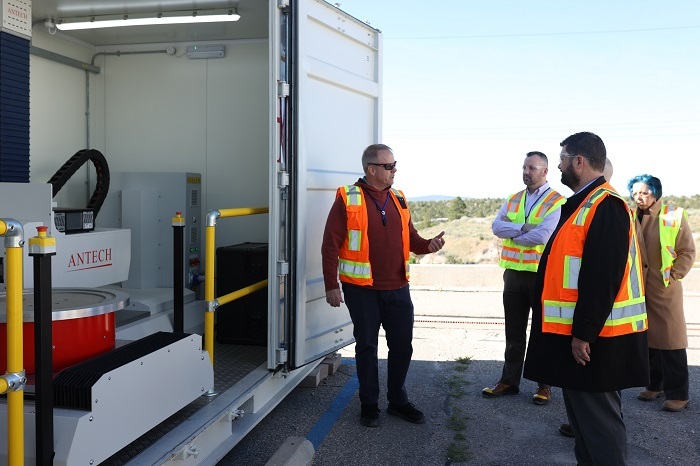 On a recent trip to Los Alamos, U.S. Department of Energy Office of Environmental Management Principal Deputy Assistant Secretary Jeff Avery, front right, received a status report on the Universal Drum Assay and Segregation System demonstration. The Newport News Nuclear BWXT Los Alamos team has been working since 2022 to prepare for the demonstration, which began in March by analyzing a test set of 400 drums containing transuranic waste.
LOS ALAMOS, N.M. — The U.S. Department of Energy (DOE) Office of Environmental Management Los Alamos Field Office (EM-LA) and Newport News Nuclear BWXT Los Alamos (N3B), the legacy cleanup contractor at Los Alamos National Laboratory (LANL), are demonstrating a new system to more accurately analyze the contents of radioactive waste drums.
This new system has the potential to enhance the measurement and characterization of legacy waste, which could optimize space for the disposition of transuranic waste at EM’s Waste Isolation Pilot Plant (WIPP).
“In addition to a more accurate and quicker analysis of waste drums, the Universal Drum Assay and Segregation System (UDASS) could allow for more efficient use of cleanup dollars for legacy waste operations,” said Jeff Holland, N3B’s manager for the UDASS project.
The system was developed by ANTECH, which designs and manufactures nuclear measurement equipment, and is being demonstrated at LANL by Nuvision Engineering (NVE), which provides engineering and technology solutions to the nuclear industry.
Current methods for identifying and quantifying waste in containers are not as sensitive as UDASS. Systems used in the U.S. today are conservative in evaluating container contents.
Transuranic waste is waste that contains radioactive elements that have atomic numbers higher than uranium on the periodic table of elements, such as plutonium and americium, and emit alpha particles, or radiation, greater than 100 nanocuries per gram.
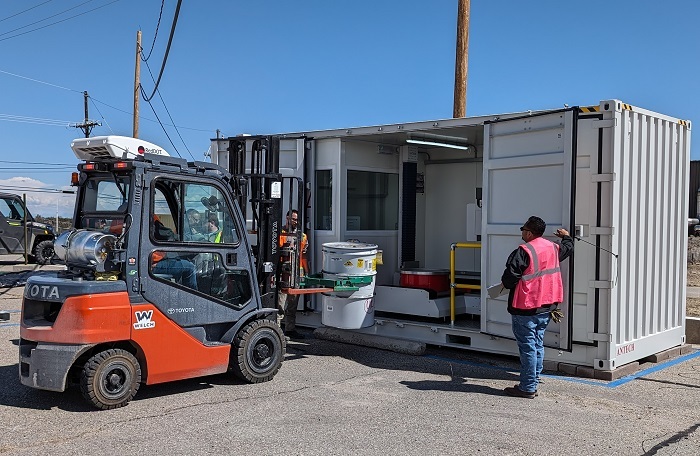 Workers place a container of legacy waste in the Universal Drum Assay and Segregation System at Technical Area 54 at Los Alamos National Laboratory, where the system is being demonstrated to more accurately analyze the radioactive contents in drums, especially transuranic waste content.
UDASS uses multiple measurement technologies and sophisticated analysis, leading to a more sensitive analysis. If the test is successful, deployment of UDASS could decrease and expedite transuranic waste shipments from Technical Area 54, Area G at LANL.
“By using more sophisticated measuring techniques, we can safely reduce the uncertainty in the waste determinations and increase the efficiency of shipping waste offsite,” said Holland.
He added, “At LANL, for example, our cleanup work includes retrieving and processing hundreds of transuranic waste containers for shipment to WIPP. The more sensitive analysis should better differentiate between transuranic and low-level waste.”
Because it had shown success at the Sellafield Site in the United Kingdom, EM decided to have UDASS demonstrated in the United States to show its viability for U.S. waste streams. N3B agreed to take on the complex integration of the new technology into an existing facility as part of its legacy waste cleanup responsibilities at LANL.
The team has been working since 2022 to select and prepare a site, design the necessary infrastructure, adapt existing processes to recognize a new system, select a population of waste containers for the demonstration and provide site training to the NVE operators.
In March 2024, the N3B and NVE team began analyzing a test set of 400 legacy waste drums known to contain 80 to 400 nanocuries per gram of waste.
The demonstration is expected to be completed this summer, and the data will be processed and analyzed by EM and ANTECH. Then, EM will compare them to the known nanocuries per container to determine how UDASS may benefit cleanup work at LANL and, perhaps, across the nation.
-Contributor: Todd Nelson
 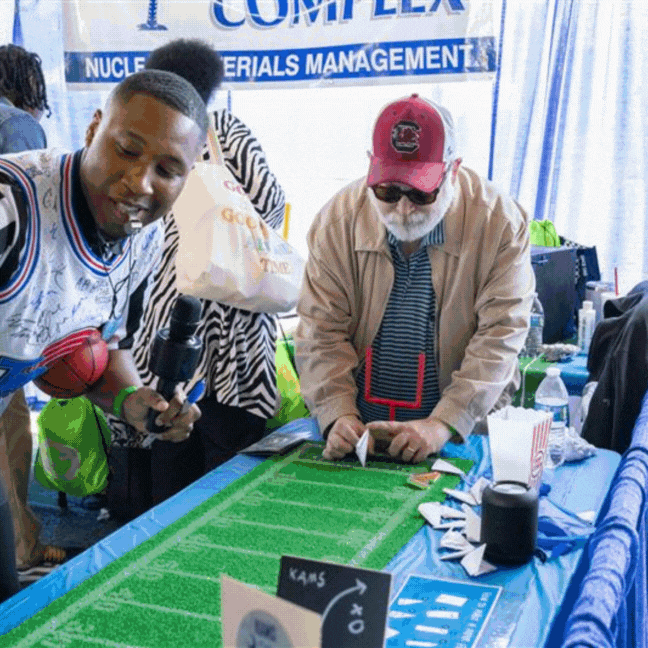 Booths at the Savannah River Site Safety Expo offered fun games that engaged attendees in safety discussions.
AIKEN, S.C. — With help from the U.S. Department of Energy Office of Environmental Management (EM), the Savannah River Site (SRS) recently hosted its annual Safety Expo, featuring over 70 informational booths designed to educate and engage employees on a range of topics that underpin the site’s legacy of safety culture and performance.
This year’s event, held at a new location, the New Ellenton Parks and Recreation Center in New Ellenton, South Carolina, welcomed more than 4,000 attendees from all SRS contractors for two days of safety engagement.
It was sponsored by Savannah River Nuclear Solutions (SRNS), the SRS management and operations contractor. SRNS shared information with site employees ranging from safety, security and environmental stewardship to personal health, wellness and other community services designed to improve quality of life.
“Every year, the SRS Safety Expo brings employees from across the site together to celebrate and reinforce our workforce’s strong safety culture,” said Rick Sprague, SRNS senior vice president, Environment, Safety, Health and Quality. “Involvement in these events is what empowers our team with the knowledge necessary to continuously improve safety at work, at home and in the community.”
 This year’s Savannah River Site Safety Expo was bigger than ever, as its new location allowed for the event to expand, including more informational booths and vendors.
Twenty-six employee-led Local Safety Improvement Teams (LSITs) hosted interactive booths at the expo, along with participants from EM liquid waste contractor Savannah River Mission Completion, the U.S. Forest Service, Savannah River National Laboratory and security services contractor Centerra-SRS, as well as several community organizations.
The expo featured multiple new initiatives intended to promote safety engagement. Attendees collected stamps on their LSIT “passport” from various LSIT booths and submitted it for a chance to win a prize. The site implemented a QR code registration system to improve the collection of attendance information.
“This year’s Safety Expo really showcased our workforce’s passion for safety,” said Ashley Allen, H Area Operations support specialist and H Area Wise Owls LSIT chair. “I enjoyed the addition of the Local Safety Improvement Team passport; it was a fun way to encourage employees to engage with these teams while we promoted safety. Pairing that experience with delicious food and the outdoor atmosphere made it difficult to leave an incredible event.”
The Safety Expo empowers employees by providing opportunities to expand safety knowledge, according to Lea Simons, Safety Expo planning lead and Health and Safety manager.
“Empowered employees are happier and healthier; we saw so many smiling faces this year,” Simons said.
SRNS President and CEO Dennis Carr said safety has and always will be a core value at SRS.
“Thank you to everyone who comes together each year to make this event possible and encourage our employees to become more engaged with the safety organizations across the site,” he said.
-Contributor: Fallan Flatow
|